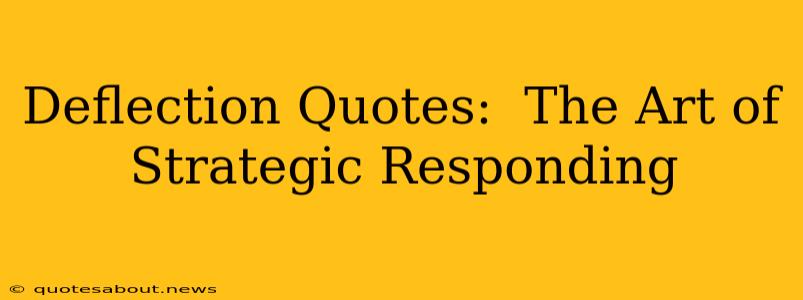Deflection, in its simplest form, is the art of skillfully redirecting attention away from a potentially uncomfortable or damaging topic. While often viewed negatively, deflection can be a powerful communication tool when used strategically and ethically. Mastering the art of deflection involves understanding the nuances of language, context, and body language to guide conversations towards more productive or comfortable territories. This isn't about lying or avoiding accountability; it's about navigating challenging situations with grace and control. This article delves into the strategic use of deflection, exploring effective techniques and showcasing examples of deflection quotes. We’ll also address common concerns and ethical considerations.
What is Deflection in Communication?
Deflection isn't about evasion; it's about strategic redirection. It involves acknowledging a question or statement while subtly shifting the focus to a related but less problematic area. Think of it as a graceful sidestep, rather than a full retreat. Effective deflection preserves relationships while managing potentially awkward or damaging conversations. It’s a crucial skill in negotiations, conflict resolution, and everyday interactions.
Effective Techniques for Deflecting Difficult Questions
Several techniques can be employed to deflect uncomfortable questions or comments effectively. These techniques rely on subtle shifts in focus and carefully chosen language:
-
Answering the question indirectly: Instead of directly addressing a potentially sensitive point, you can provide a relevant but less direct response. For example, if asked about a personal failing, you might highlight a related strength or positive achievement.
-
Focusing on the positive: This technique shifts the focus from negative aspects to positive ones. For instance, if criticized for a mistake, you could acknowledge the error while emphasizing the positive outcomes or lessons learned.
-
Using humor: Well-placed humor can diffuse tension and redirect attention. A witty remark or self-deprecating joke can often disarm a challenging question or comment. However, ensure the humor is appropriate to the situation and audience.
-
Asking a counter-question: This redirects the focus back to the questioner or changes the subject entirely. For example, responding to a critical question with "What makes you say that?" shifts the focus and invites further clarification.
-
Bridging to a related topic: This involves smoothly transitioning from the original topic to a related but less problematic one. This requires careful word choice and smooth transitions to avoid appearing evasive.
Examples of Deflection Quotes
Here are a few examples illustrating how deflection can be used effectively:
-
Instead of: "I made a mistake."
-
Try: "I learned a valuable lesson from that experience, and I'll ensure it doesn't happen again." (Focuses on positive growth)
-
Instead of: "Why did you miss the deadline?"
-
Try: "Let's focus on how we can get this project back on track. What are your suggestions?" (Shifts focus to solution-finding)
-
Instead of: "I don't know."
-
Try: "That's a good question. Let me get back to you with a definitive answer after I've had a chance to check." (Promises future response without immediate commitment)
Is Deflection Ethical?
The ethical use of deflection hinges on honesty and intent. It should never be used to deceive or mislead. Instead, it should be employed to navigate difficult situations gracefully and professionally. Unethical deflection often involves avoiding accountability or manipulating the conversation for personal gain. Ethical deflection, on the other hand, preserves relationships while managing challenging interactions responsibly.
When is Deflection Appropriate?
Deflection is appropriate in situations where:
- The question is overly personal or intrusive: In these scenarios, a subtle shift in focus protects personal boundaries.
- The question is irrelevant to the current conversation: Redirecting attention to relevant topics keeps the discussion productive.
- The question is based on inaccurate information: Correcting the underlying assumptions can be more productive than directly addressing a flawed premise.
- The question is intended to provoke a negative response: Skillful deflection can de-escalate the situation and avoid unnecessary conflict.
When is Deflection Inappropriate?
Deflection is inappropriate when:
- It involves lying or withholding information: Honesty is paramount; deflection should not be used to conceal the truth.
- It avoids taking responsibility for one's actions: Accountability is crucial; deflection shouldn't be used to evade consequences.
- It manipulates or deceives others: Ethical communication requires transparency and respect; deflection should not be used for malicious intent.
Conclusion: The Art of Strategic Deflection
Mastering the art of deflection involves skillful communication and a deep understanding of context. When used ethically and strategically, deflection can be a valuable tool for navigating challenging conversations, building stronger relationships, and protecting one's reputation. The key is to redirect, not deceive. By using these techniques thoughtfully and responsibly, you can effectively manage difficult situations while preserving your integrity.

